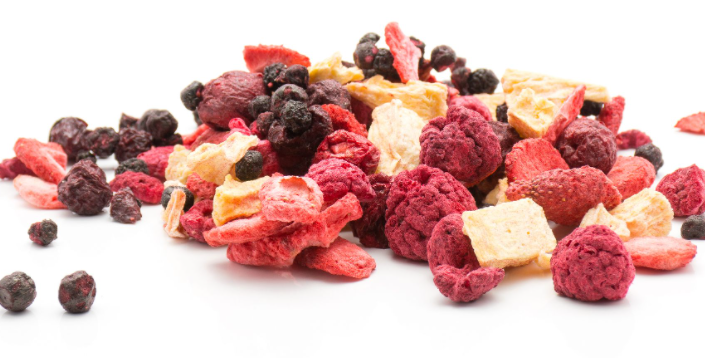Freeze drying, also known als lyophilization, is a water removal process used to preserve perishable materials.
Freeze-drying is commonly used for coffee, fruit, juice, vegetables, herbs, food flavorings, fish, seafood, eggs, and dairy. Individual food types can be freeze-dried, as can dishes with multiple ingredients, such as stews or soups.
History of Freeze Drying
The Inca have been freeze drying potatoes into chuño since the 13th century. The process involved multiple cycles of exposing potatoes to below freezing temperatures on mountain peaks in the Andes during the evening, and squeezing water out and drying them in the sunlight during the day.

A significant turning point for freeze drying occurred during World War II when Blood plasma and penicillin were needed to treat the wounded in the field. Because of the lack of refrigerated transport, many serum supplies spoiled before reaching their recipients The freeze-drying process was developed as a commercial technique that enabled blood plasma and penicillin to be rendered chemically stable and viable without refrigeration In the 1950s–1960s, freeze drying began to be viewed as a multi-purpose tool for both pharmaceuticals and food processing
Freeze-dried foods became a major component of astronaut and military rations. What began for astronaut crews as tubed meals and freeze-dried snacks that were difficult to rehydrate, were transformed into hot meals in space by improving the process of rehydrating freeze-dried meals with water. As technology and food processing improved, NASA looked for ways to provide a complete nutrient profile while reducing crumbs, disease-producing bacteria, and toxins.The complete nutrient profile was improved with the addition of an algae-based vegetable-like oil to add polyunsaturated fatty acids.
How Does Freeze-Drying Work?
We distinguis 3 phases:
Preparation & Freezing: Fruits or vegetables are washed, peeled/cut and frozen. Freezing preserves its physical form. It can be done in a freezer, a chilled bath or on a shelf in the freeze dryer.
Primary drying (sublimation): the pressure is lowered and heat is added to the material in order for the water to sublimate. The vacuum speeds sublimation. The cold condenser provides a surface for the water vapor to adhere and solidify. The condenser also protects the vacuum pump from the water vapor. About 95% of the water in the material is removed in this phase. Primary drying can be a slow process.
Secondary Drying (Adsorption): the ionically-bound water molecules are removed. By raising the temperature higher than in the primary drying phase, the bonds are broken between the material and the water molecules. Freeze dried materials retain a porous structure. After the freeze drying process is complete, the vacuum can be broken with an inert gas before the material is sealed. Most materials can be dried to 1-5% residual moisture.
Why Is Freeze Drying A Good Option For Food Processing?
- Makes it possible to manufacture food products that have a long shelf life and don’t require refrigeration.
- A great way of processing surplus produce, such as seasonal fruits and vegetables, into high value foods, to reduce waste.
- The quality of products is excellent
- Freeze dried strawberries maintain their original shape
- Freeze dried food retains most of its nutrition and flavours: formulating with freeze-dried foods allows you to reduce or replace artificial additives, while offering natural antioxidants, vitamins, and minerals to help your labeling claims
Cons
- high energy input required
- high acquisition costs for the required equipment
- large amount of time required in contrast to other drying methods
- more expensive as conventional drying - so it is most suitable for products which increase in value with processing.
- Costs are also variable depending on the product, the packaging material and processing capacity.
Process Comparision

Challenges During Freeze Drying
- Heating the product too high in temperature can cause melt-back or product collapse
- Condenser overload caused by too much vapor hitting the condenser ( Too much vapor creation, surface area, too small a condenser area, nsufficient refrigeration)
- Vapor choking – the vapor is produced at a rate faster than it can get through the vapor port, the port between the product chamber and the condenser, creating an increase in chamber pressure.
More Than Food
Pharmaceutical companies often use freeze-drying to increase the shelf life of the products, such as live virus vaccines, biologics and other injectables. By removing the water from the material and sealing the material in a glass val, the material can be easily stored, shipped, and later reconstituted to its original form for injection. Another example from the pharmaceutical industry is the use of freeze drying to produce tablets or wafers, the advantage of which is less excipient as well as a rapidly absorbed and easily administered dosage form.
Freeze-dried pharmaceutical products are produced as lyophilized powders for reconstitution in vials and more recently in prefilled syringes for self-administration by a patient.
Freeze-drying is also used in manufacturing of raw materials for pharmaceutical products. Active Pharmaceutical Product Ingredients (APIs) are lyophilized to achieve chemical stability under room temperature storage. Bulk lyophilization of APIs is typically conducted using trays instead of glass vials.
Freeze drying applications across many industries
diagnostics, biotech, nanoparticles, microbiome, nutraceuticals, ceramics, enzyme extractin, bacterias, bio fuels, cosmetics, soil additive, wood pulp......
Because it is a cost intensive technology, the purchase of own equipment is not always the best choice. We can help you to get in touch with companies that offer freeze-drying services for your product.
What product, which amount and what do you expect from a the final result?
For Freeze Drying Terminology follow the link
_________
Title picture source:
Getty Images/Kateryna Bibro from https://www.thespruceeats.com/what-is-freeze-dried-fruit-5193827

